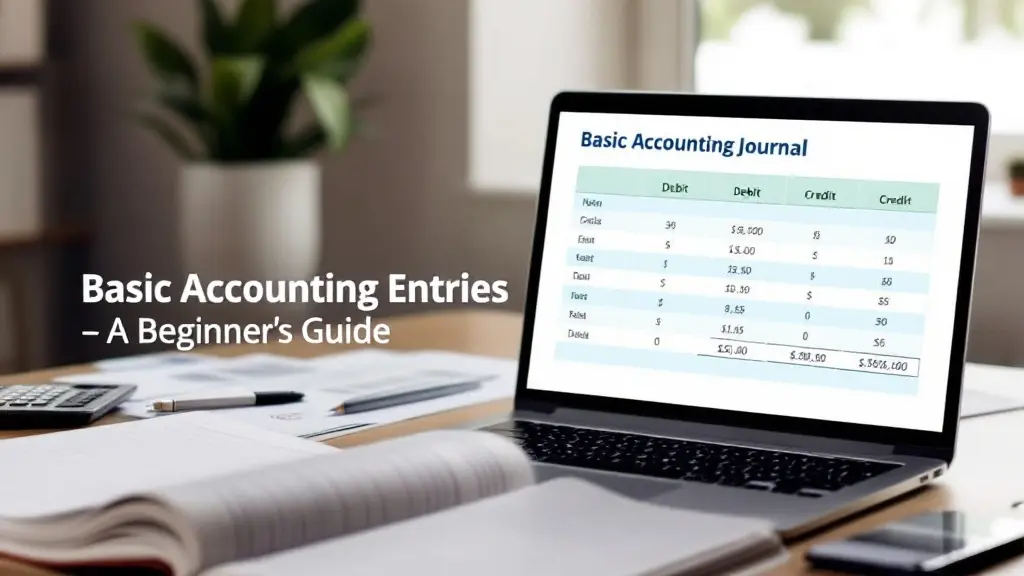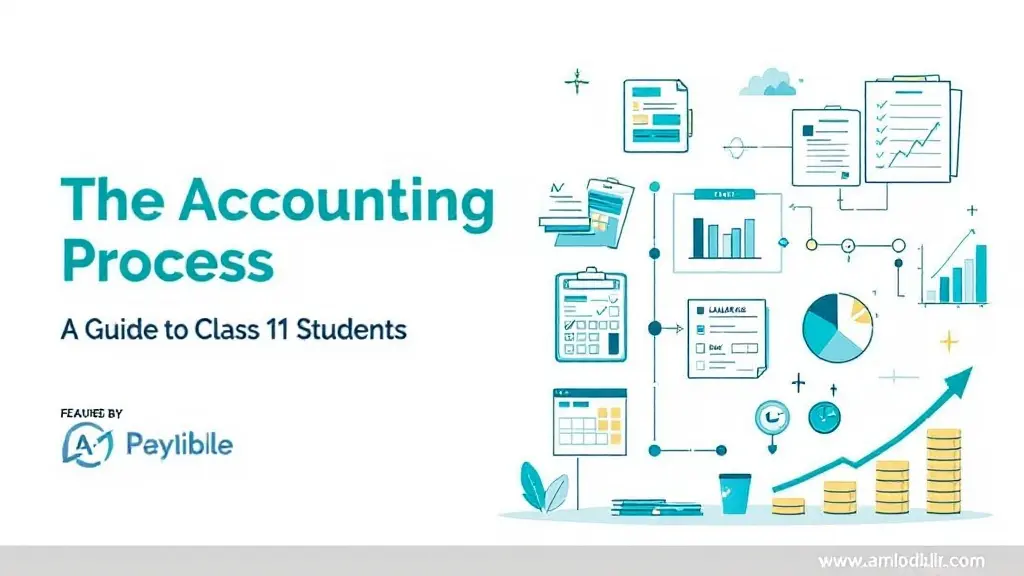Basic Accounting Entries: A Beginner’s Guide to Journal Entries
Table of Contents
Most Read
[fusion_dropcap class="fusion-content-tb-dropcap"]W[/fusion_dropcap]hether you’re running a business, managing your personal finances, or studying commerce, understanding basic accounting entries is essential. These entries are the foundation of any accounting system and help track financial transactions in a structured way.
In this post, we’ll break down what basic accounting entries are, how they work, and walk you through common examples — all in simple, human-friendly language.
🧾 What Are Accounting Entries?
In accounting, an entry refers to the formal record of a financial transaction in the accounting books. Every time money moves—whether you’re making a sale, buying supplies, or paying salaries—you need to record it.
Each entry reflects:
- What happened (the transaction),
- When it happened (the date),
- How much was involved (the amount),
- And where the money came from and went (accounts affected).
These entries are recorded in something called a journal, which is why they’re also known as journal entries.
🔁 The Double-Entry System: The Backbone of Accounting
Accounting works on the double-entry system, which means every transaction affects at least two accounts—one gets debited, the other gets credited.
Here’s a simple way to remember it:
| Type of Account | Increase | Decrease |
|---|---|---|
| Asset | Debit | Credit |
| Liability | Credit | Debit |
| Equity | Credit | Debit |
| Income/Revenue | Credit | Debit |
| Expense | Debit | Credit |
This method keeps your books balanced, which is why we always say:
Total Debits = Total Credits.
📘 Types of Basic Accounting Entries
Let’s explore the most common types of journal entries that you’ll encounter:
1. Cash Entry
When money is received or paid in cash.
Example:
You pay ₹2,000 in cash for office supplies.
cssCopyEditOffice Supplies A/C Dr. ₹2,000
To Cash A/C ₹2,000
2. Bank Entry
When transactions are done via bank.
Example:
You receive ₹10,000 from a client directly in your bank account.
cssCopyEditBank A/C Dr. ₹10,000
To Sales A/C ₹10,000
3. Purchase Entry
When goods are purchased (usually for resale).
Example:
You buy goods worth ₹5,000 on credit from a supplier.
cssCopyEditPurchases A/C Dr. ₹5,000
To Supplier A/C ₹5,000
4. Sales Entry
When goods are sold (usually from inventory).
Example:
You sell goods worth ₹8,000 to a customer on credit.
cssCopyEditCustomer A/C Dr. ₹8,000
To Sales A/C ₹8,000
5. Expense Entry
For costs like rent, salaries, utilities, etc.
Example:
You pay ₹3,000 as office rent.
cssCopyEditRent A/C Dr. ₹3,000
To Cash/Bank A/C ₹3,000
6. Income Entry
Recording non-sales income like interest, commission, etc.
Example:
You earn ₹500 in interest from the bank.
cssCopyEditBank A/C Dr. ₹500
To Interest Income A/C ₹500
7. Contra Entry
For transferring funds between cash and bank.
Example:
You deposit ₹5,000 cash into the bank.
cssCopyEditBank A/C Dr. ₹5,000
To Cash A/C ₹5,000
8. Adjustment Entry
Made at the end of an accounting period to adjust revenues or expenses.
Example:
You accrued ₹1,200 salary for March but will pay it in April.
cssCopyEditSalary Expense A/C Dr. ₹1,200
To Salary Payable A/C ₹1,200
🧠 How to Write a Basic Journal Entry
Here’s a step-by-step guide:
Step 1: Identify the transaction
Example: You paid electricity bill ₹1,500.
Step 2: Decide which accounts are affected
- Electricity Expense (an expense – increase → Debit)
- Cash (an asset – decrease → Credit)
Step 3: Apply the debit and credit rule
cssCopyEditElectricity Expense A/C Dr. ₹1,500
To Cash A/C ₹1,500
Step 4: Write a brief narration
(Being electricity bill paid in cash)
📊 Why Are Basic Accounting Entries Important?
- ✅ Financial Accuracy: Keeps your books clean and accurate.
- ✅ Legal Compliance: Ensures you’re meeting tax and regulatory requirements.
- ✅ Decision Making: Helps in budgeting, forecasting, and financial planning.
- ✅ Audit Trail: Creates a reliable record for auditors and stakeholders.
📝 Pro Tips for Beginners
- Use accounting software like Tally, Zoho Books, or QuickBooks if you’re not into manual entry.
- Maintain consistency in account naming and structure.
- Reconcile your accounts monthly to catch errors early.
- Never skip narrations—they help clarify the nature of each transaction.
- Practice regularly by writing journal entries from real-life examples.
📚 Quick Reference: Common Journal Entries Cheat Sheet
| Transaction | Journal Entry |
|---|---|
| Owner invests cash | Cash A/C Dr. To Capital A/C |
| Purchase goods for cash | Purchases A/C Dr. To Cash A/C |
| Sales made in cash | Cash A/C Dr. To Sales A/C |
| Rent paid | Rent A/C Dr. To Bank/Cash A/C |
| Salary paid | Salary A/C Dr. To Bank/Cash A/C |
| Goods sold on credit | Debtor A/C Dr. To Sales A/C |
| Goods purchased on credit | Purchases A/C Dr. To Creditor A/C |
| Cash withdrawn from bank | Cash A/C Dr. To Bank A/C |
| Bank loan received | Bank A/C Dr. To Loan A/C |
🌟 Final Thoughts
Understanding basic accounting entries doesn’t require a finance degree. With a little practice, you’ll start seeing patterns and logic in every transaction. Whether you’re an entrepreneur, student, or freelancer, mastering journal entries is your first step toward financial confidence.
If you found this guide helpful, share it with your peers or bookmark it for future reference. And remember, good accounting is good business!
📌 Frequently Asked Questions (FAQs)
❓ What are the golden rules of accounting?
- Personal Account: Debit the receiver, credit the giver
- Real Account: Debit what comes in, credit what goes out
- Nominal Account: Debit all expenses/losses, credit all incomes/gains
❓ Are journal entries part of financial statements?
Not directly, but they form the base for ledgers, which are then used to prepare trial balances and financial statements.
❓ Can I use Excel for journal entries?
Yes! Excel is a great tool for small businesses or learners to practice and manage basic journal entries.
Basic Accounting Entries: A Beginner’s Guide to Journal Entries
Keywords: basic accounting entries, journal entries, double-entry accounting, types of accounting entries, debit and credit, accounting for beginners
Whether you’re running a business, managing your personal finances, or studying commerce, understanding basic accounting entries is essential. These entries are the foundation of any accounting system and help track financial transactions in a structured way.
In this post, we’ll break down what basic accounting entries are, how they work, and walk you through common examples — all in simple, human-friendly language.
🧾 What Are Accounting Entries?
In accounting, an entry refers to the formal record of a financial transaction in the accounting books. Every time money moves—whether you’re making a sale, buying supplies, or paying salaries—you need to record it.
Each entry reflects:
- What happened (the transaction),
- When it happened (the date),
- How much was involved (the amount),
- And where the money came from and went (accounts affected).
These entries are recorded in something called a journal, which is why they’re also known as journal entries.
🔁 The Double-Entry System: The Backbone of Accounting
Accounting works on the double-entry system, which means every transaction affects at least two accounts—one gets debited, the other gets credited.
Here’s a simple way to remember it:
| Type of Account | Increase | Decrease |
|---|---|---|
| Asset | Debit | Credit |
| Liability | Credit | Debit |
| Equity | Credit | Debit |
| Income/Revenue | Credit | Debit |
| Expense | Debit | Credit |
This method keeps your books balanced, which is why we always say:
Total Debits = Total Credits.
📘 Types of Basic Accounting Entries
Let’s explore the most common types of journal entries that you’ll encounter:
1. Cash Entry
When money is received or paid in cash.
Example:
You pay ₹2,000 in cash for office supplies.
cssCopyEditOffice Supplies A/C Dr. ₹2,000
To Cash A/C ₹2,000
2. Bank Entry
When transactions are done via bank.
Example:
You receive ₹10,000 from a client directly in your bank account.
cssCopyEditBank A/C Dr. ₹10,000
To Sales A/C ₹10,000
3. Purchase Entry
When goods are purchased (usually for resale).
Example:
You buy goods worth ₹5,000 on credit from a supplier.
cssCopyEditPurchases A/C Dr. ₹5,000
To Supplier A/C ₹5,000
4. Sales Entry
When goods are sold (usually from inventory).
Example:
You sell goods worth ₹8,000 to a customer on credit.
cssCopyEditCustomer A/C Dr. ₹8,000
To Sales A/C ₹8,000
5. Expense Entry
For costs like rent, salaries, utilities, etc.
Example:
You pay ₹3,000 as office rent.
cssCopyEditRent A/C Dr. ₹3,000
To Cash/Bank A/C ₹3,000
6. Income Entry
Recording non-sales income like interest, commission, etc.
Example:
You earn ₹500 in interest from the bank.
cssCopyEditBank A/C Dr. ₹500
To Interest Income A/C ₹500
7. Contra Entry
For transferring funds between cash and bank.
Example:
You deposit ₹5,000 cash into the bank.
cssCopyEditBank A/C Dr. ₹5,000
To Cash A/C ₹5,000
8. Adjustment Entry
Made at the end of an accounting period to adjust revenues or expenses.
Example:
You accrued ₹1,200 salary for March but will pay it in April.
cssCopyEditSalary Expense A/C Dr. ₹1,200
To Salary Payable A/C ₹1,200
🧠 How to Write a Basic Journal Entry
Here’s a step-by-step guide:
Step 1: Identify the transaction
Example: You paid electricity bill ₹1,500.
Step 2: Decide which accounts are affected
- Electricity Expense (an expense – increase → Debit)
- Cash (an asset – decrease → Credit)
Step 3: Apply the debit and credit rule
cssCopyEditElectricity Expense A/C Dr. ₹1,500
To Cash A/C ₹1,500
Step 4: Write a brief narration
(Being electricity bill paid in cash)
📊 Why Are Basic Accounting Entries Important?
- ✅ Financial Accuracy: Keeps your books clean and accurate.
- ✅ Legal Compliance: Ensures you’re meeting tax and regulatory requirements.
- ✅ Decision Making: Helps in budgeting, forecasting, and financial planning.
- ✅ Audit Trail: Creates a reliable record for auditors and stakeholders.
📝 Pro Tips for Beginners
- Use accounting software like Tally, Zoho Books, or QuickBooks if you’re not into manual entry.
- Maintain consistency in account naming and structure.
- Reconcile your accounts monthly to catch errors early.
- Never skip narrations—they help clarify the nature of each transaction.
- Practice regularly by writing journal entries from real-life examples.
📚 Quick Reference: Common Journal Entries Cheat Sheet
| Transaction | Journal Entry |
|---|---|
| Owner invests cash | Cash A/C Dr. To Capital A/C |
| Purchase goods for cash | Purchases A/C Dr. To Cash A/C |
| Sales made in cash | Cash A/C Dr. To Sales A/C |
| Rent paid | Rent A/C Dr. To Bank/Cash A/C |
| Salary paid | Salary A/C Dr. To Bank/Cash A/C |
| Goods sold on credit | Debtor A/C Dr. To Sales A/C |
| Goods purchased on credit | Purchases A/C Dr. To Creditor A/C |
| Cash withdrawn from bank | Cash A/C Dr. To Bank A/C |
| Bank loan received | Bank A/C Dr. To Loan A/C |
🌟 Final Thoughts
Understanding basic accounting entries doesn’t require a finance degree. With a little practice, you’ll start seeing patterns and logic in every transaction. Whether you’re an entrepreneur, student, or freelancer, mastering journal entries is your first step toward financial confidence.
If you found this guide helpful, share it with your peers or bookmark it for future reference. And remember, good accounting is good business!
📌 Frequently Asked Questions (FAQs)
❓ What are the golden rules of accounting?
- Personal Account: Debit the receiver, credit the giver
- Real Account: Debit what comes in, credit what goes out
- Nominal Account: Debit all expenses/losses, credit all incomes/gains
❓ Are journal entries part of financial statements?
Not directly, but they form the base for ledgers, which are then used to prepare trial balances and financial statements.
❓ Can I use Excel for journal entries?
Yes! Excel is a great tool for small businesses or learners to practice and manage basic journal entries.
Visit Our Website : Accounting24.in









